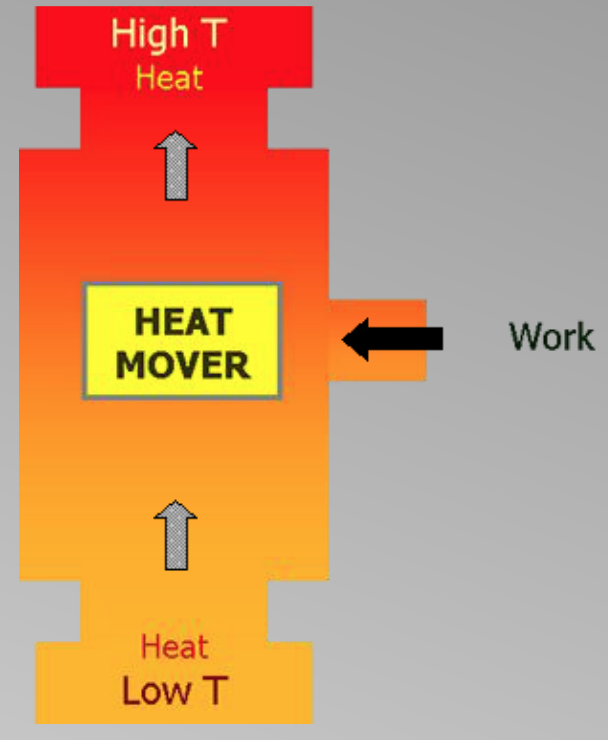8.5: Cooling and Heating (I)
- Page ID
- 47199
Heat Movers
So far, we have discussed systems in which a fuel is burned and heat is produced and delivered into the home. In these systems, we buy all the energy, and (depending on the system) we reject or lose some heat to the surroundings, reducing the efficiency.
One of the ways in which we can improve the heating efficiency is to make use of the heat that is available outside, even on a cold winter day. On a cold winter day with outside temperature at 30ºF, the air still has more energy compared to air at 10 ºF or 5ºF. Air at any temperature above absolute zero (0ºK or -273 ºC) will have energy.
The higher the temperature of air, the higher its energy content. This energy can be transferred to the interior.
A device that moves the heat from a low temperature environment to a high temperature environment is called a heat mover.
Under natural circumstances, heat only flows from high temperatures to low temperatures. In order to move heat from a low temperature environment to a high temperature environment, work needs to be done (or rather energy needs to be spent), as shown in Figure 8.2.1.

Figure 8.2.1. Heat mover
Heat Pumps
An example of a heat mover is a heat pump. A heat pump is a heating/cooling system and also a forced-air system. Cooled (and sometimes humidified or electronically cleaned) air is usually delivered through the same ductwork and registers used by heated air.
A heat pump uses air-conditioning principles to extract heat from one place and deliver it to another, and vice versa. In addition to expelling heat from indoors, the system can be reversed to heat the home in the winter. Thus a heat pump is a device that moves heat from a low-temperature to a high-temperature environment with the help of work that is put in.
Heat pumps are classified based on the low-temperature heat source:
- Air-source heat pump or Air-to-air heat pump. Heat is transferred from the low-temperature air outside to the high-temperature interior.
- Ground-source heat pump or Ground-to-air heat pump. The earth is used as a heat sink in the summer and a heat source in the winter; the pump relies on the relative warmth of the earth for its heating and cooling production.
- Water-source heat pump or Water-to-air heat pump. Heat is transferred from low-temperature water outside (from a pond or a lake) to a high-temperature interior.
Additional Information
An air conditioner is a cooling system and also a forced-air system. It runs on electricity and removes heat from the air with basic refrigeration principles.


